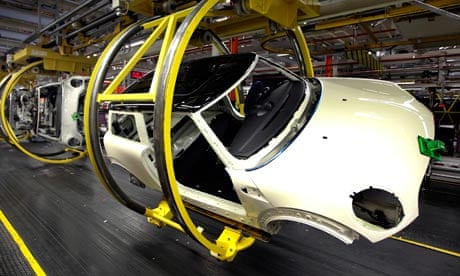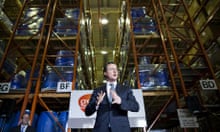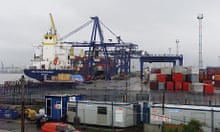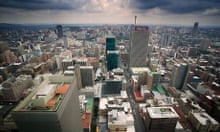The UK's slow recovery remains on course after manufacturing data released on Monday showed the sector grew for a fourth consecutive month in March and a survey of nearly 8,000 businesses shows increasing optimism across the UK.
Manufacturers said orders improved on the previous month, adding to the impression that the economy has narrowly avoided a double dip recession in the first three months of the year.
According to the Market/Cips purchasing managers' index (PMI), the British manufacturing sector expanded at its fastest pace in 10 months, as factories worked through a backlog of existing orders and stockpiled goods in warehouses.
The headline index jumped to 52.1 in March, beating forecasts of a reading of 50.7. The poll also revised February's reading from 51.2 up to 51.5. Any figure over 50 represents growth, while less than 50 shows a contraction in activity.
A separate report from the British Chambers of Commerce, released on Monday, points to "a welcome but modest improvement in the economic situation" with small increases in domestic and export orders – though they remain below pre-recession levels. More manufacturers and service firms are also expecting to recruit staff.
The BCC Quarterly Economic Survey – in which 7,981 independent businesses participated – predicts 0.3% growth in the first three months of this year. However, the BCC also suggests that full year growth will be 0.6%, less than the 0.8% expected by the Office for Budget Responsibility, because "unresolved problems in the eurozone may trigger new upheavals later this year".
John Longworth, the director-general of the BCC, said he was encouraged that business confidence was improving, but growth remained too slow. He called on the government to come up with more policies to foster growth.
The BCC survey represents a turnround from the end of last year, when it was predicting stagflation – a grim combination of zero growth and inflation.
The reports are likely to cheer the Treasury after a fortnight that started with the granny tax debacle during the chancellor's budget and ended with George Osborne parrying questions from MPs on his reasons for applying VAT to pasties.
Markets reacted positively to the manufacturing figures, with the FTSE 100 climbing 106 points or 1.84%. Other European markets followed suit, though more in reaction to a rise in the US's main manufacturing index and a more positive than expected survey of Chinese manufacturers. The S&P index climbed nearly 1% to 1420.99 - a four year high. The Dow was up 76 at 13288 by mid-afternoon.
Andrew Goodwin, senior economic adviser to the Ernst & Young ITEM Club, said the strength of orders suggested the recovery will take hold. "Another encouraging set of results, which makes it almost certain that the economy will have returned to growth in the first quarter. Official data for the manufacturing sector was already pointing to a reasonably good first quarter and Monday's figures provide further evidence that this will be the case.
"Based upon the official data available so far and recent business surveys, we expect manufacturing output to have grown by 0.8% on the quarter. It looks as if GDP will have grown by around 0.3% in the first quarter, fully reversing the decline in the fourth quarter of 2011."
In the United States, stockmarkets started the second quarter with a bang, with the S&P 500 climbing to a fresh four-year high as manufacturing data from the US helped support the outlook for economic growth. The Dow Jones industrial average added 52.45 points, or 0.40%, to 13,264.49 at the close. The S&P 500 rose 10.43 points to 1,418.90.
The US manufacturing PMI for March rose to 53.4, up from 52.4 last month – better than economists had forecast. The data means America's factory sector has been in expansion for 32 months in a row. In comparison, the eurozone PMI has now shrunk for the last eight months.
"The market is telling you it believes the US economy has turned around, it has made that corner, it is clearly moving higher - especially compared to Europe and parts of Asia," said Ken Polcari, managing director of Icap Equities in New York.
Recent signals from the UK economy have helped the government, which is under pressure to show that businesses are doing well despite its controversial public spending cuts and tax rises. The Market/Cips data raised some concerns about inflation after figures showed the prices manufacturers are paying for materials have shot up.
Samuel Tombs at Capital Economics said cost pressures cast some doubt over recovery. "Given that a pickup in price pressures appeared to contribute to the manufacturing slowdown in the second half of last year, it seems as if the industrial recovery is still built on shaky foundations."
The ITEM Club added: "The only fly in the ointment is on the costs and prices side. At the moment the rise in raw materials costs is being reflected in a squeeze on margins. However, the longer that input prices continue to rise, the greater the chance that it will feed through to consumer prices. This in turn would reinforce the pressure on household finances and place a significant question mark over the prospects for a sustained recovery this year."
In 2010 the PMI almost hit 60, driven by rising exports. The UK was on course for a recovery led by manufacturing. But during 2011, as fears grew over the euro, the sector started to contract, opening up a war of words between the chancellor and Labour over the economic prospects.
Manufacturing recovery has done little so far to bring down unemployment. The figures for March showed factory employment was largely unchanged. David Noble, chief executive at the Chartered Institute of Purchasing and Supply, said: "Headcounts are being kept to a minimum in part to offset the chronic rising cost of raw materials."







